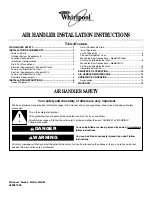
9
V3.15.22
IV.III. Cellar Construction
Insulation
CellarPro cooling units are designed to be installed inside wine cellars that have
proper insulation, moisture barriers and an airtight seal from the environment
outside the cellar. Interior walls and floor should have a minimum of R-11
insulation, and a vapor barrier
on the warm side of the
insulation. The ceiling should
have a minimum of R-19
insulation and a vapor barrier
on the warm side of the
insulation. Doors also should
be insulated and tightly
sealed
with
weather
s t r i p p i n g a r o u n d t h e
perim eter of the door.
Surface-mounted
fixtures
are recommended over
recessed lighting, which can
allow air to leak into the
cellar.
It is important that all walls,
joints, doors and windows, electrical outlets and/or switches, pipes, vents and
light fixtures be sealed to prevent air and moisture from entering the cellar. If there is
a leak in the cellar, the cooling unit will build up excess condensation.
The drain line (shipped loose with the cooling unit) must be connected to the drain
pan (as shown in the installation section).
Fan Speeds
Your fan speed setting will depend on the thermal load on the wine cellar, and the
resulting BTU that is required to cool and maintain your wine cellar at the desired
temperature. If the unit is ducted, the high fan speed always should be used.
Ventilation
Adequate ventilation is critically important for the proper operation of your CellarPro
cooling unit.










































